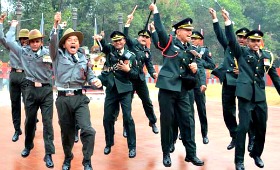As per the AFCAT 2017 Syllabus we can see General Knowledge for Verbal Ability for AFCAT exam paper have MCQs based on Indian Economy, you must practice enough questions before facing it in the exam. Indian Economy refers to an entire network of producers, distributors, and consumers of goods and services in India.
AFCAT 1 2017 General Knowledge Sample Questions on Indian Economy
National Level AFCAT 1 2016 Mock Test Series ! ENROL NOW
- Development expenditure of the Central government does not include
A. defence expenditure
B. expenditure on economic services
C. expenditure on social and community services
D. grant to states
- Gilt-edged market means
A. bullion market
B. market of government securities
C. market of guns
D. market of pure metals
- If all the banks in an economy are nationalized and converted into a monopoly bank, the total deposits
A. will decrease
B. will increase
C. will neither increase nor decrease
D. None of the above
- India changed over to the decimal system of coinage in
A. April 1995
B. April 1957
C. April 1958
D. April 1959
- States earn maximum revenue through
A. land revenue
B. custom revenue
C. commercial taxes
D. excise duties on intoxicants
- Excise duty is a tax levied on the
A. import of goods
B. export of goods
C. production of goods
D. sale of goods
- Deficit financing means that the government borrows money from the
A. RBI
B. local bodies
C. big businessmen
D. IMF
- Notes on which denomination has the portrait of Mahatma Gandhi printed on them?
A. 1000 rupee
B. 500 rupee
C. 100 rupee
D. All of the above
- Reserve Bank of India was nationalized in the year
A. 1935
B. 1945
C. 1949
D. 1969
- The annual yield from which of the following Union Government taxes is the highest?
A. Custom duties
B. Corporation tax and income tax
C. Inheritance tax, wealth tax, interest tax and gift tax
D. Excise duties
- Subsidies mean
A. payment by government for purchase of goods and services
B. payment made by business enterprises to factors of production
C. payment made by companies to shareholders
D. payment made by the government to business enterprises, without buying any goods and services
- Resurgent India Bonds were issued in US dollar, Pound Sterling and
A. Japanese Yen
B. Deutsche Mark
C. Euro
D. French Franc
- Which of the following is not an undertaking under the administrative control of Ministry of Railways?
A. Container Corporation of India Limited
B. Konkan Railway Corporation Limited
C. Indian Railways Construction Company Limited
D. Diesel Locomotive Works, Varanasi
- Short-term finance is usually for a period ranging up to
A. 5 months
B. 10 months
C. 12 months
D. 15 months
- In India, which one among the following formulates the fiscal policy?
A. Planning Commission
B. Ministry of Finance
C. Finance Commission
D. The Reserve Bank of India
- Devaluation of currency leads to
A. fall in domestic prices
B. increase in domestic prices
C. no impact on domestic prices
D. erratic fluctuations in domestic prices
- Deficit financing implies
A. printing new currency notes
B. replacing new currency with worn out currency
C. public expenditure in excess of public revenue
D. public revenue in excess of public expenditure
- In which of the following sequences the change in quantity of money leads to change in price level in the Keynesian models?
A. Change in quantity of money – change in investment – change in employment and output – change in rate of interest – change in price level
B. Change in quantity of money – change in employment and output – change in investment – change in the rate of interest – change in price level
C. Change in quantity of money – change in investment – change in rate of interest – change in employment and output – change in price level
D. Change in quantity of money – change in rate of interest – change in investment – change in employment and output – change in price level




















